Welcome to Tunadorable's weekly AI newsletter, where we summarize his favorite articles of the week that he plans to read.
This article was written by gpt-3.5-turbo-16k on 2024-06-21.
# 3D-RPE - Enhancing Long-Context Modeling Through 3D Rotary Position Encoding
In this paper, the authors propose a novel position encoding mechanism called 3D Rotary Position Encoding (3D-RPE) to enhance the long-context modeling capability of Transformer-based language models (LLMs). 3D-RPE is an advanced version of the widely used 2D Rotary Position Encoding (RoPE), with two major advantages. First, it allows for the control of long-term decay within the chunk size, ensuring the modeling of relative positional information between tokens at a distant relative position. Second, it mitigates the reduction in positional resolution caused by position interpolation on RoPE.
The authors conducted experiments on long-context Natural Language Understanding (NLU) and long-sequence Language Modeling (LM) tasks. The results show that LLMs combined with 3D-RPE achieved performance improvements, especially in long-context NLU tasks.
The core assertion of this paper is that 3D-RPE, with its controllable long-term decay and enhanced position resolution, can effectively improve the long-context modeling capability of LLMs. The methodology involves constructing position encoding on a 3D rotating sphere and evaluating its performance through experiments on NLU and LM tasks.
The results of the experiments support the authors' claims, showing significant performance improvements when using 3D-RPE in long-context NLU tasks. The potential implication of this research is that 3D-RPE can enhance the capabilities of LLMs in understanding and generating long-context language, which has practical applications in various natural language processing tasks.
One potential critique of this research is that the experiments were conducted on specific LLM models (LLaMA) and datasets, which may limit the generalizability of the findings. Further research and experimentation on different models and datasets would be beneficial to validate the effectiveness of 3D-RPE more comprehensively.
# An elementary proof of a universal approximation theorem
This paper presents an elementary proof of a universal approximation theorem for neural networks with three hidden layers. The theorem states that neural networks with continuous, bounded activation functions can approximate any continuous function on a compact set with arbitrary accuracy. The proof relies on basic concepts from undergraduate analysis and uses separation lemmas to show that the collection of neural networks with three hidden layers and a specific activation function is dense in the space of continuous functions. The result is weaker than the best-known results, but the proof is elementary and intuitive. Potential critiques could include the limitation to three hidden layers and the use of a specific activation function. The implications of the theorem are that neural networks with three hidden layers can be powerful tools for approximating complex functions in various applications.
# Breaking the Attention Bottleneck
This research paper explores the limitations of traditional attention mechanisms in transformer models and proposes a more efficient and scalable alternative. The paper introduces a generative function as attention replacement, which reduces the computational complexity and resource requirements of transformers while maintaining or improving language modeling performance.
The methodology involves replacing the auto-regressive attention mechanism in nanoGPT with a static function that compares each token with the previous one. This simple concept already achieves a smaller loss value with a smaller model size and reduces computational cost.
The results show that the proposed attention replacement yields a smaller loss value and reduces the model size in comparison to traditional attention mechanisms. Incorporating an average context vector further improves the loss value. The approach is also effective in an over-parameterized setting.
The implications of this research are that attention mechanisms can be replaced with more efficient alternatives, reducing the computational demands of transformer models. This opens up possibilities for deploying these models in resource-constrained environments and enhances interpretability and transparency.
Potential critiques of the research could include the need for further evaluation on different datasets and downstream tasks to assess the generalizability of the proposed method. Additionally, the trade-off between computational cost and performance improvement should be carefully considered.
The implications of this research are significant for the field of natural language processing and AI in general, as it offers a more efficient and interpretable alternative to traditional attention mechanisms. It has the potential to make transformer models more accessible and scalable for a broader range of applications.
# In Tree Structure Should Sentence Be Generated
This paper introduces a new method for generating sentences in natural language by using a tree-traversing order, which addresses issues such as hallucinations and getting trapped in a logic loop. The method is based on the theoretical certainty that sentences follow a tree-like structure, with words of greater weight being generated earlier. The approach is compared to the diffusion model in graphic generation and a module called SenTree is introduced for generating an approximating binary tree. The proposed approach, integrated with the transformer model, achieves better performance in translation tasks compared to the baseline transformer model. The paper also discusses the potential of refining the tree structure generation model based on BERT when the generative language model's loss is not decreasing. The joint training framework, incorporating generative adversarial networks, is proposed for further enhancement.
# Transcendence - Generative Models Can Outperform The Experts That Train Them
This research paper explores the concept of "transcendence" in generative models, which refers to the models' ability to surpass the performance of the human experts who generate their training data. The authors demonstrate this phenomenon by training a chess-playing model using game transcripts from human players. They show that the trained model can sometimes outperform all the human players in the dataset.
The paper provides theoretical proofs for the conditions under which transcendence is possible. It shows that low-temperature sampling, which induces a majority vote among the experts, is necessary for transcendence. The authors also demonstrate empirically that low-temperature sampling enables transcendence in the chess-playing model.
The results of the experiments show that the model achieves better performance than the human players when the temperature is set to a low value. The authors visualize the distribution of reward changes and find that the model performs significantly better on a small subset of states that are crucial for determining the outcome of the game.
One potential critique of the study is the assumption that all experts are sampled uniformly at random, which may not hold in certain real-world scenarios. Additionally, the paper focuses on a specific domain (chess) and may not generalize to other domains. However, the findings provide valuable insights into the capabilities of generative models and the potential for transcending human experts in certain contexts.
The implications of this research are significant as it challenges the common assumption that generative models can only match the performance of human experts. The study suggests that, under certain conditions, generative models can actually surpass the abilities of their expert sources. This opens up new possibilities for the application of generative models in various domains.
# Be like a Goldfish, Don't Memorize! Mitigating Memorization in Generative LLMs
This research paper introduces a technique called the "goldfish loss" to mitigate the problem of language model memorization. Memorization in language models can lead to copyright and privacy risks. The goldfish loss modifies the training objective of the model by excluding a randomly sampled subset of tokens from the loss computation. This prevents the model from memorizing the excluded tokens and reproducing them verbatim at inference time.
The researchers conducted extensive experiments using billion-scale language models, both pre-trained and trained from scratch. They found that training models with the goldfish loss significantly reduced extractable memorization while having little to no impact on downstream benchmarks.
The paper discusses related work on mitigating memorization in language models, such as differential privacy training and data deduplication. It also compares the goldfish loss to other regularization techniques and explains how it differs in its approach.
The results of the experiments demonstrate that the goldfish loss effectively prevents memorization in extreme scenarios where models are trained on a small number of articles. It also shows that the goldfish loss can prevent memorization in standard training setups, where models are trained on larger datasets.
The researchers analyze the impact of the goldfish loss on model performance. They find that models trained with the goldfish loss perform similarly to models trained with the standard loss on various evaluation benchmarks. They also observe a mild slowdown in pretraining with the goldfish loss but note that the language modeling ability is comparable when both models are allowed the same number of supervised tokens for loss computation.
Overall, the goldfish loss provides a simple and effective method to mitigate memorization in language models, reducing copyright and privacy risks without significantly impacting model performance. Potential critiques of this approach could include the selection of the drop frequency and the reliance on hashing for handling duplicate passages. Further research could explore alternative methods for token dropping and evaluate the effectiveness of the goldfish loss in other domains or applications.
# Can LLMs Learn Macroeconomic Narratives from Social Media?
This study examines the hypothesis that narratives spread through social media can influence economic fluctuations. The researchers collected two datasets of economy-related tweets from Twitter and used natural language processing methods to extract and summarize the narratives within them. They then tested the predictive power of these narratives for macroeconomic forecasting by incorporating them into financial prediction tasks. The results showed that while the extracted narratives provided some improvement in prediction accuracy, the overall impact was marginal compared to using only financial information. This suggests that narratives may not have a significant influence on macroeconomic predictions. The study provides valuable insights and tools for extracting and summarizing narratives from social media using large language models, contributing to future research on the role of narratives in economics.
# Amphista - Accelerate LLM Inference with Bi-directional Multiple Drafting Heads in a Non-autoregressive Style
This paper presents Amphista, a non-autoregressive decoding algorithm for large language models (LLMs) that improves inference speed without sacrificing generation quality. Amphista incorporates an Auto-embedding Block that enables interaction between different drafting heads, improving prediction accuracy. It also introduces Staged Adaptation Layers to bridge the paradigm gap between autoregressive and non-autoregressive models and enhance feature fusion. Experimental results show that Amphista achieves up to 2.75x speed-up compared to vanilla autoregressive decoding and outperforms other baseline methods like Medusa and Hydra. The findings demonstrate the efficiency and scalability of the proposed approach.
# Provable Guarantees for Model Performance via Mechanistic Interpretability
This paper proposes a novel approach to generating compact proofs of model performance using mechanistic interpretability. The authors train a set of transformers on a simple task and reverse engineer the models to gain a mechanistic understanding of their behavior. They then use this understanding to construct proofs that lower bound the model's accuracy. The authors explore different proof strategies and find that more compact proofs require and provide more mechanistic understanding. They also find a trade-off between proof length and tightness of bound, with more faithful mechanistic understanding leading to tighter bounds. However, they identify compounding structureless noise as a challenge for generating compact proofs. The authors provide a quantitative metric for assessing the mechanistic understanding used in a proof strategy and use it to evaluate their proofs. They also qualitatively examine the proofs to confirm the relationship between proof length and understanding. Overall, this work demonstrates the potential of mechanistic interpretability for generating compact proofs of model performance.
# Locating and Extracting Relational Concepts in Large Language Models
This research paper investigates the representation of relational concepts in large language models (LLMs) and proposes a method to locate and extract these representations. The authors observe that hidden states at the last token position of the input prompt solely express the causal effects of relational concepts. Based on this observation, they hypothesize that these hidden states can be treated as relational representations and successfully extracted from LLMs. The authors conduct experiments to validate their hypothesis, including hidden states transplantation and zero-shot relational reasoning. The results demonstrate that the extracted relational representations accurately capture relational concepts and can be used for controllable fact recall and reasoning. The research has implications for understanding the interpretability of LLMs and enhancing their ability to recall and reason about factual knowledge.
# Accessing GPT-4 level Mathematical Olympiad Solutions via Monte Carlo Tree Self-refine with LLaMa-3 8B
This paper introduces the MCT Self-Refine (MCTSr) algorithm, which combines large language models (LLMs) with Monte Carlo Tree Search (MCTS) to enhance performance in complex mathematical reasoning tasks. The algorithm constructs a search tree through iterative processes of selection, self-refinement, self-evaluation, and backpropagation, utilizing an improved Upper Confidence Bound (UCB) formula to optimize exploration-exploitation balance. The experiments demonstrate MCTSr's efficacy in solving Olympiad-level mathematical problems, significantly improving success rates across multiple datasets. The integration of LLMs and MCTS enhances decision-making accuracy and reliability in mathematical reasoning tasks, setting a foundation for future AI applications.
# In-Context Former - Lightning-fast Compressing Context for Large Language Model
Researchers have proposed a new method called In-Context Former (IC-Former) for compressing long contexts in large language models (LLMs) to improve inference efficiency. Unlike previous methods that rely on the self-attention mechanism of the LLM, IC-Former leverages the cross-attention mechanism and a small number of learnable digest tokens to directly condense information from the contextual word embeddings. This approach significantly reduces the computational overhead of compression and achieves linear growth in time complexity within the compression range. Experimental results show that IC-Former requires only 1/32 of the floating-point operations of the baseline during compression and improves processing speed by 68 to 112 times while maintaining over 90% of the baseline performance on evaluation metrics. This means that IC-Former effectively reduces compression costs and makes real-time compression scenarios feasible.
# Complex fractal trainability boundary can arise from trivial non-convexity
This study investigates the emergence of fractal trainability boundaries in neural networks. The researchers found that even simple non-convex perturbations to loss functions can lead to fractal trainability boundaries. They constructed loss functions with additive or multiplicative perturbations and applied gradient descent (GD) to examine the boundary between learning rates that lead to bounded versus divergent losses. They discovered that the fractal dimensions of the trainability boundaries are influenced by factors such as the type of non-convexity, perturbation wavelength, and perturbation amplitude. The researchers identified "roughness of perturbation" as a key factor controlling the fractal dimensions of trainability boundaries. They observed a transition from non-fractal to fractal trainability boundaries as the roughness increases, with the critical roughness causing the perturbed loss function to become non-convex. The findings suggest that fractal trainability boundaries can arise from very simple non-convexity. These findings contribute to our understanding of complex behaviors during neural network training and have the potential to improve training strategies.
# Distributional reasoning in LLMs - Parallel reasoning processes in multi-hop reasoning
This paper investigates the internal reasoning processes of large language models (LLMs) by analyzing their ability to perform multi-hop reasoning tasks. The authors propose a novel concept called "distributional reasoning" which suggests that LLMs generate a distribution of potential intermediate answers during the inference process of compositional reasoning questions. They demonstrate that the prediction process for these questions can be approximated using a simple linear transformation between two semantic category spaces. The middle layers of the network generate highly interpretable embeddings that represent the potential intermediate answers, and there is a correlation between the activation patterns of the intermediate and final answers. These findings hold true even when the model lacks the necessary knowledge to solve the task. The authors also introduce a new dataset of fake items to track the activation of intermediate states. The results provide insights into the strategies and processes used by LLMs to solve reasoning tasks, bridging the gap between human cognitive processes and artificial intelligence.
# Mixture-of-Agents Enhances Large Language Model Capabilities
The authors propose a new approach called Mixture-of-Agents (MoA) to leverage the collective expertise of multiple large language models (LLMs) and enhance their performance. They demonstrate that LLMs exhibit collaborativeness, where they generate better responses when provided with outputs from other models, even if those outputs are of lower quality. The MoA methodology consists of multiple layers of LLMs, with each layer refining the responses generated by the previous layer. The authors evaluate MoA on benchmarks such as AlpacaEval 2.0, MT-Bench, and FLASK, and achieve state-of-the-art performance, surpassing GPT-4 Omni. The results highlight the effectiveness of MoA in leveraging the strengths of multiple LLMs and improving response quality.
Thanks for reading/listening, that's all for this week.
Please consider checking out Tunadorable's youtube channel where he provides commentary on the above papers.
https://youtube.com/@Tunadorable
Here is the most up-to-date version of the python scripts I currently use to create this newsletter:
https://github.com/evintunador/arxiv-summaries-workflow

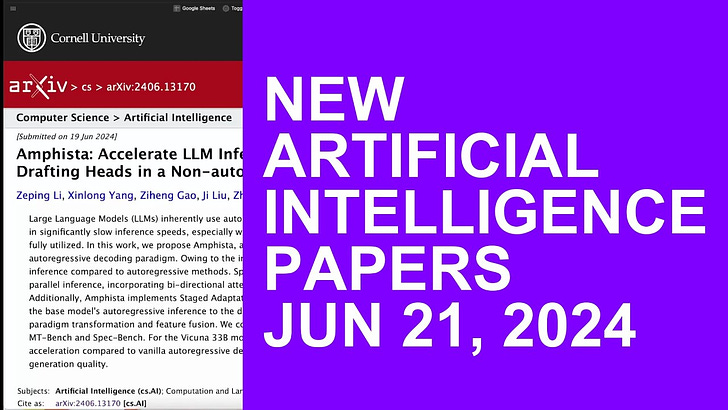




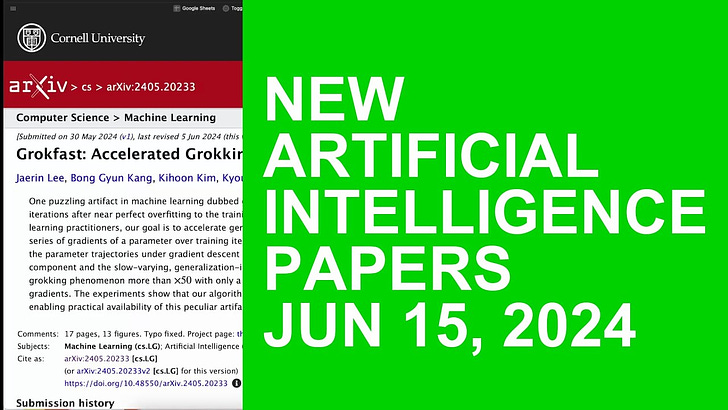
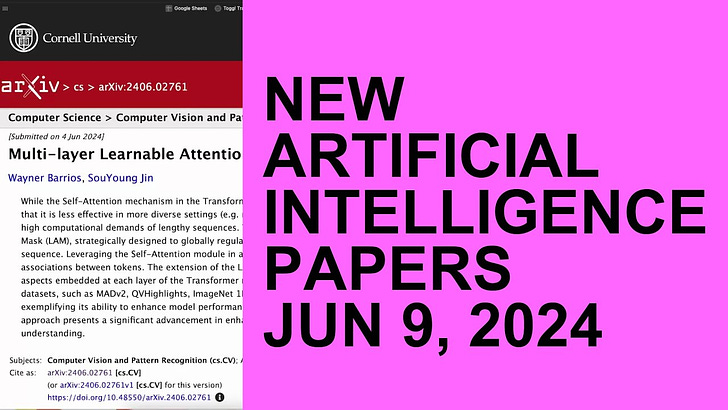
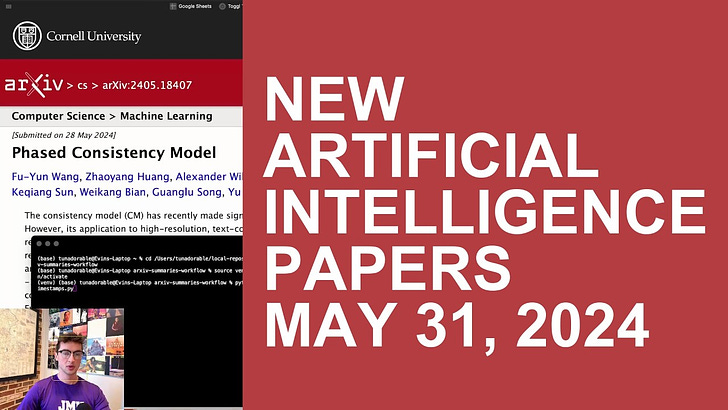
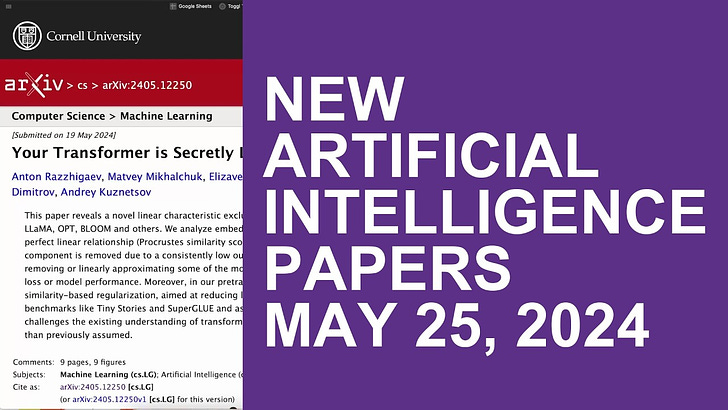
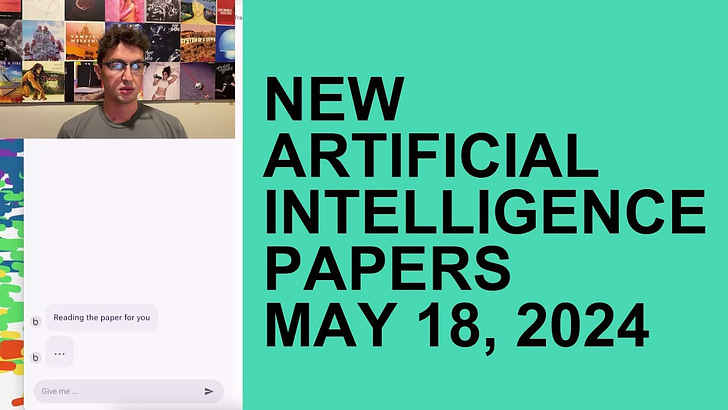
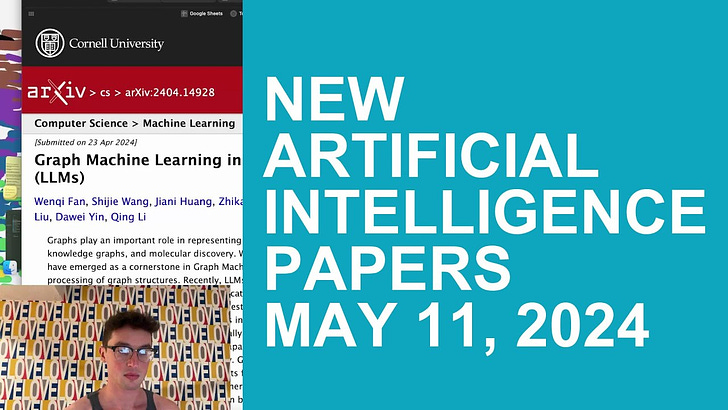
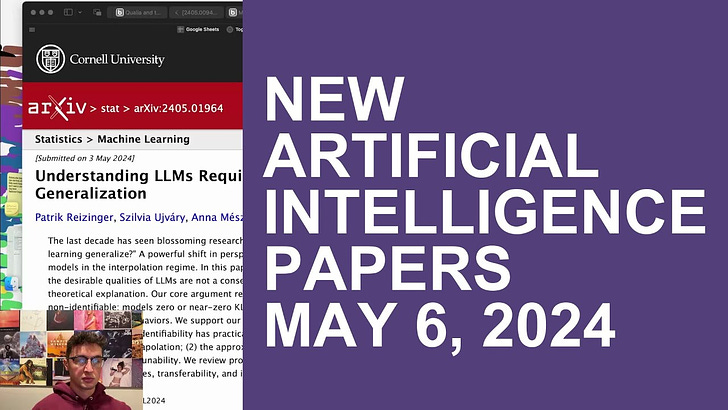
This Week's New AI Papers